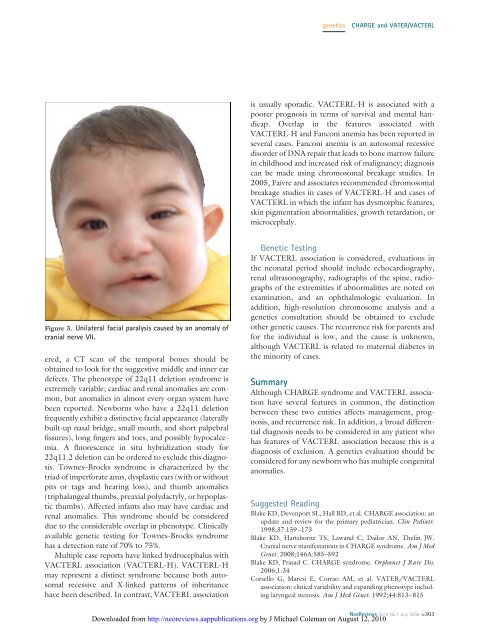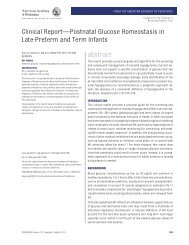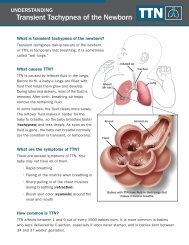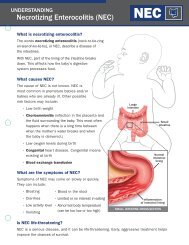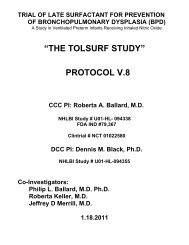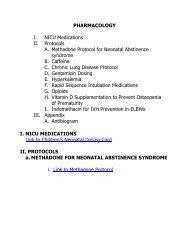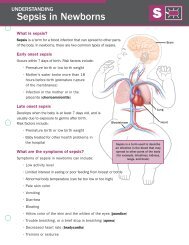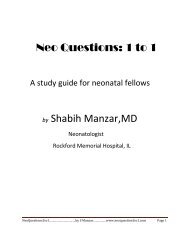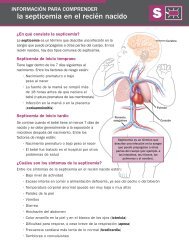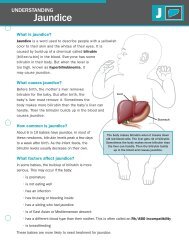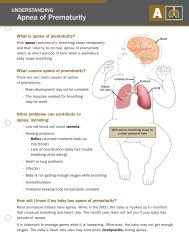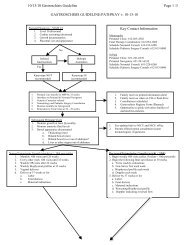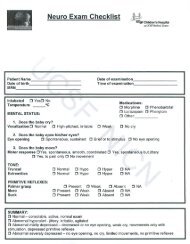Neonatal Presentations of CHARGE Syndrome and VATER
Neonatal Presentations of CHARGE Syndrome and VATER
Neonatal Presentations of CHARGE Syndrome and VATER
- No tags were found...
Create successful ePaper yourself
Turn your PDF publications into a flip-book with our unique Google optimized e-Paper software.
genetics<strong>CHARGE</strong> <strong>and</strong> <strong>VATER</strong>/VACTERLis usually sporadic. VACTERL-H is associated with apoorer prognosis in terms <strong>of</strong> survival <strong>and</strong> mental h<strong>and</strong>icap.Overlap in the features associated withVACTERL-H <strong>and</strong> Fanconi anemia has been reported inseveral cases. Fanconi anemia is an autosomal recessivedisorder <strong>of</strong> DNA repair that leads to bone marrow failurein childhood <strong>and</strong> increased risk <strong>of</strong> malignancy; diagnosiscan be made using chromosomal breakage studies. In2005, Faivre <strong>and</strong> associates recommended chromosomalbreakage studies in cases <strong>of</strong> VACTERL-H <strong>and</strong> cases <strong>of</strong>VACTERL in which the infant has dysmorphic features,skin pigmentation abnormalities, growth retardation, ormicrocephaly.Figure 3. Unilateral facial paralysis caused by an anomaly <strong>of</strong>cranial nerve VII.ered, a CT scan <strong>of</strong> the temporal bones should beobtained to look for the suggestive middle <strong>and</strong> inner eardefects. The phenotype <strong>of</strong> 22q11 deletion syndrome isextremely variable; cardiac <strong>and</strong> renal anomalies are common,but anomalies in almost every organ system havebeen reported. Newborns who have a 22q11 deletionfrequently exhibit a distinctive facial appearance (laterallybuilt-up nasal bridge, small mouth, <strong>and</strong> short palpebralfissures), long fingers <strong>and</strong> toes, <strong>and</strong> possibly hypocalcemia.A fluorescence in situ hybridization study for22q11.2 deletion can be ordered to exclude this diagnosis.Townes–Brocks syndrome is characterized by thetriad <strong>of</strong> imperforate anus, dysplastic ears (with or withoutpits or tags <strong>and</strong> hearing loss), <strong>and</strong> thumb anomalies(triphalangeal thumbs, preaxial polydactyly, or hypoplasticthumbs). Affected infants also may have cardiac <strong>and</strong>renal anomalies. This syndrome should be considereddue to the considerable overlap in phenotype. Clinicallyavailable genetic testing for Townes-Brocks syndromehas a detection rate <strong>of</strong> 70% to 75%.Multiple case reports have linked hydrocephalus withVACTERL association (VACTERL-H). VACTERL-Hmay represent a distinct syndrome because both autosomalrecessive <strong>and</strong> X-linked patterns <strong>of</strong> inheritancehave been described. In contrast, VACTERL associationGenetic TestingIf VACTERL association is considered, evaluations inthe neonatal period should include echocardiography,renal ultrasonography, radiographs <strong>of</strong> the spine, radiographs<strong>of</strong> the extremities if abnormalities are noted onexamination, <strong>and</strong> an ophthalmologic evaluation. Inaddition, high-resolution chromosome analysis <strong>and</strong> agenetics consultation should be obtained to excludeother genetic causes. The recurrence risk for parents <strong>and</strong>for the individual is low, <strong>and</strong> the cause is unknown,although VACTERL is related to maternal diabetes inthe minority <strong>of</strong> cases.SummaryAlthough <strong>CHARGE</strong> syndrome <strong>and</strong> VACTERL associationhave several features in common, the distinctionbetween these two entities affects management, prognosis,<strong>and</strong> recurrence risk. In addition, a broad differentialdiagnosis needs to be considered in any patient whohas features <strong>of</strong> VACTERL association because this is adiagnosis <strong>of</strong> exclusion. A genetics evaluation should beconsidered for any newborn who has multiple congenitalanomalies.Suggested ReadingBlake KD, Devenport SL, Hall BD, et al. <strong>CHARGE</strong> association: anupdate <strong>and</strong> review for the primary pediatrician. Clin Pediatr.1998;37:159–173Blake KD, Hartshorne TS, Law<strong>and</strong> C, Dailor AN, Thelin JW.Cranial nerve manifestations in <strong>CHARGE</strong> syndrome. Am J MedGenet. 2008;146A:585–592Blake KD, Prasad C. <strong>CHARGE</strong> syndrome. Orphanet J Rare Dis.2006;1:34Corsello G, Maresi E, Corrao AM, et al. <strong>VATER</strong>/VACTERLassociation: clinical variability <strong>and</strong> exp<strong>and</strong>ing phenotype includinglaryngeal stenosis. Am J Med Genet. 1992;44:813–815NeoReviews Vol.9 No.7 July 2008 e303Downloaded from http://neoreviews.aappublications.org by J Michael Coleman on August 12, 2010


